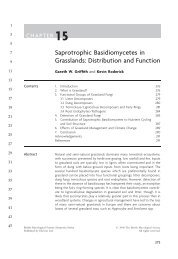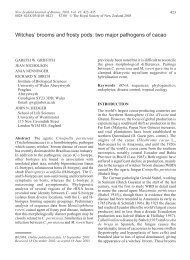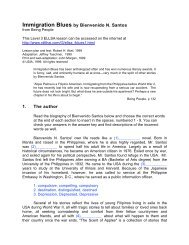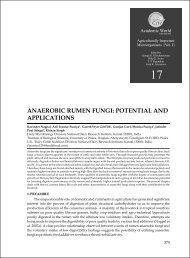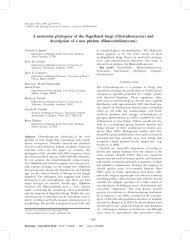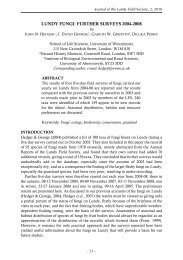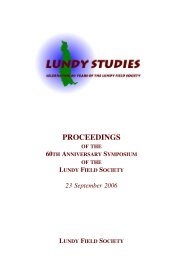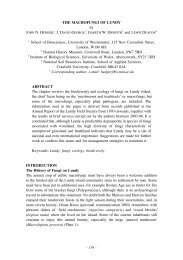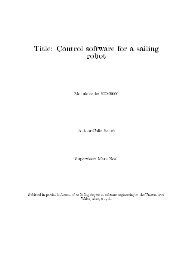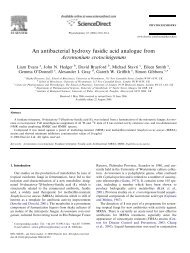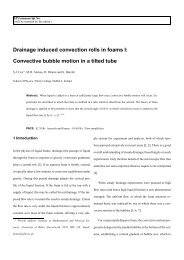Short and long-range visual navigation using warped panoramic ...
Short and long-range visual navigation using warped panoramic ...
Short and long-range visual navigation using warped panoramic ...
You also want an ePaper? Increase the reach of your titles
YUMPU automatically turns print PDFs into web optimized ePapers that Google loves.
3<br />
2<br />
1<br />
0<br />
-1<br />
-2<br />
2<br />
1<br />
0<br />
-1<br />
-2<br />
-3<br />
-2<br />
Fig. 15. Repeatability of the route following (2)<br />
-2<br />
0<br />
Fig. 16. Repeatability of the route following on a <strong>long</strong> route<br />
significantly different initial orientations of the robot. This<br />
does lead to very different trajectories, mostly because<br />
again of the late detection of the passing of the way-images.<br />
Despite this, the robot still arrives in the vicinity of the<br />
final way-image with the correct orientation.<br />
The final experiment is a route made of 8 way-images,<br />
is significantly <strong>long</strong>er, used most of the play area <strong>and</strong> was<br />
indeed close to its edges (around 1 m at the bottom of Figure<br />
16). The starting position was around (4, −0.5). Various<br />
speeds <strong>and</strong> turning rates were used (maximum speeds from<br />
0.3 m/s up to 0.6 m/s <strong>and</strong> maximum turning rates from<br />
14 ◦ /s up to 28 ◦ /s, the highest values for both being the values<br />
used for all the other experiments).<br />
As with the previous experiments, the system did<br />
wrongly detect the passing of way-images in a number of<br />
cases. This was particularly the case of way-image 6 (at<br />
position (0.25, −1.5)), which was detected just after pass-<br />
-1<br />
0<br />
2<br />
1<br />
4<br />
9<br />
ing way-image 5. In one case (highlighted in Figure 16),<br />
way-image 5 was detected while moving away from wayimage<br />
6, therefore requiring a sudden change in orientation<br />
to turn towards way-image 6. This triggered the detection<br />
of way-image 6 while the robot was very far from it<br />
(approximately at position (−2.7, −1.4)). Nevertheless,<br />
the system recovered by simply moving onto the following<br />
way-image.<br />
However, it is visible that the accuracy does degrade significantly<br />
as the robot progresses. This is partly due to the<br />
increasing error in the measurement of the robot’s orientation<br />
by the <strong>visual</strong> compass, mostly due to the fact that the<br />
robot was moving close to some objects, which is the worst<br />
situation for the <strong>visual</strong> compass (Labrosse, 2006) <strong>and</strong> for<br />
the estimation of the gradient (Section 2.2). This suggests<br />
that the orientation of the robot should indeed be updated<br />
by aligning the current image with the way-image when its<br />
passing is detected, Section 3.2. This however is not that<br />
obvious, see Section 5.<br />
5. Discussion<br />
All the results show good performance of the <strong>visual</strong> homing<br />
procedure <strong>and</strong> the <strong>long</strong>-<strong>range</strong> <strong>navigation</strong> proposed here.<br />
In particular, good repeatability has been demonstrated.<br />
The method makes a number of assumptions. The first<br />
is that, at least for the final stage of the homing, the robot<br />
must be able to turn on the spot. This is because no trajectory<br />
planning has been incorporated in the procedure<br />
to ensure that the robot arrives at the target with the correct<br />
orientation. This is obviously a problem that needs<br />
to be solved should the method be applied to a car-like<br />
robot. However, reaching the correct orientation at each<br />
way-image is not necessarily important <strong>and</strong> correct orientation<br />
could be easily reached for the final target by specifying<br />
a number of close sub-way-images just before the end<br />
of the route. Smoothing the trajectories could however be<br />
beneficial to ensure smooth transitions between segments<br />
of trajectories at the passing of way-images. This moreover<br />
might help solving the detection of this passing. This is still<br />
work in progress.<br />
The second assumption made by the method is that the<br />
same parameters of the warping used to simulate the translation<br />
of the robot for the gradient computation are suitable<br />
in all situations. This is obviously wrong. For example,<br />
the apparent motion of the objects in the images is more<br />
important for objects that are close to the robot than for<br />
far away objects. In other words, we use the “equal distance<br />
assumption” that others have also used (Franz et al., 1998):



